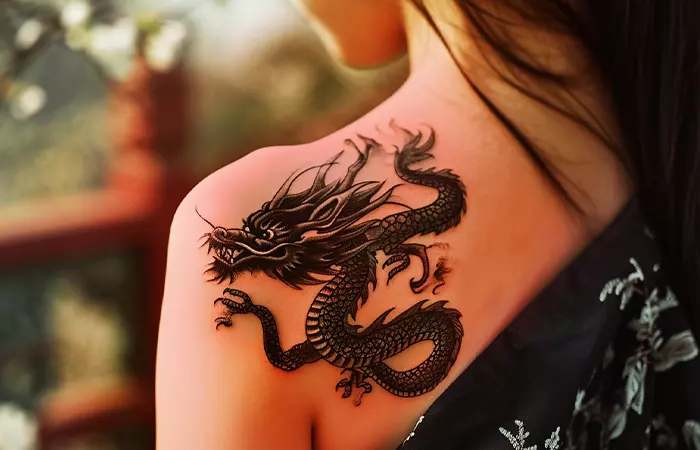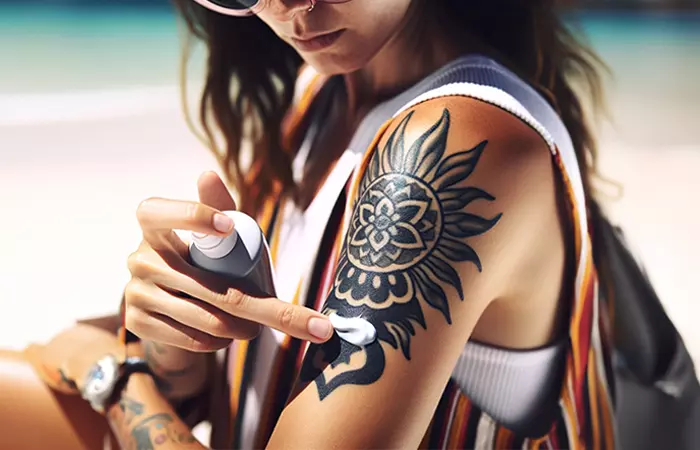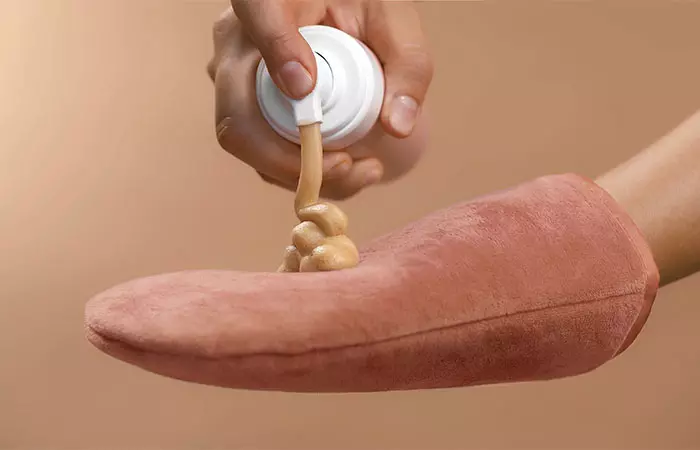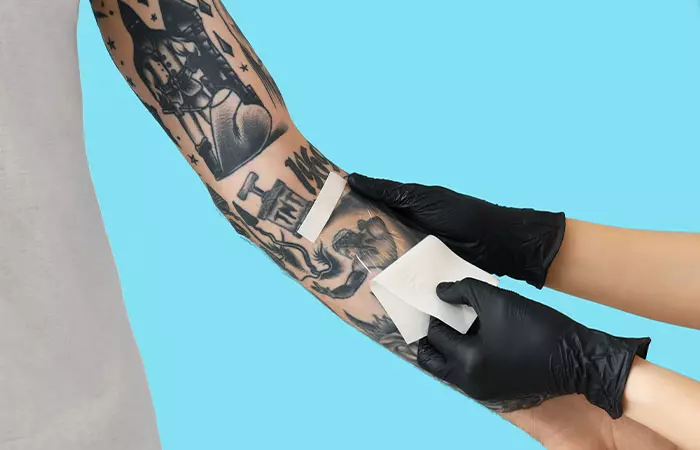
If your desire for a golden tan is irresistible enough to lure you to a tanning bed, it’s essential to understand how to protect your tattoo in a tanning bed. Tattoos are intricate works of art on your skin, filled with vibrant colors that are meant to stay vibrant for a long time. While the idea of getting a tan may be tempting, using tanning beds isn’t the best choice for your tattoos. The harsh ultraviolet rays from tanning beds can increase the risk of fading and even altering the chemistry of your tattoo. So, can you prevent your tattoo from fading in a tanning bed? Well, you can, but you should take extra precautions before tanning with a new, still-healing tattoo or even old ink to protect it from the harmful rays.
Read on to learn more about the risks of using tanning beds and tips to protect your tattoo from UV light.
Risks of tanning with tattoos
 Image: Created with Midjourney
Image: Created with Midjourney
One of the most important pieces of advice for tattoo care after getting a fresh tattoo is to protect it from direct sunlight, as ultraviolet rays can cause the tattoo to fade. Radiation from tanning beds is also a risk factor for tattooed skin. The intensity of UV rays can break down the pigments in the tattoo ink, leading to fading. This process is similar to laser tattoo removal, in that it works by focusing light onto the skin that is absorbed by the tattoo pigments, causing them to heat up and break apart (1). When fragmentation occurs, the concentration of pigment particles decreases, leading to fading of the tattoo colors. It can also change the chemistry of tattoo pigments, potentially creating toxic decomposition products.
Both sun exposure and tanning beds cause similar results, but in a less intense way for the former. Tanning beds, unlike natural sunlight, emit more concentrated UV radiation, which can lead to a multitude of common health problems, such as photoallergic effects, chronic inflammation, and oxidative stress. Furthermore, compounds in tattoo ink, along with their broken down byproducts during UV exposure, can also act as tumor promoters in tattooed skin (2).

So is it safe to tan after getting a tattoo? Whether it’s a new tattoo or an old one, artificial tanning is not a good option. Plus, the risks may be greater if you tan with new tattoos. Keep reading to learn more.
Tanning with new tattoos
 Image: Created with Dall·E
Image: Created with Dall·E
Tanning with new tattoos is more dangerous than with older tattoos. Immediately after tattooing, your tattooed skin layer is likely to be super sensitive. Therefore, it is best to avoid tanning until your tattoo has fully healed. Exposing fresh tattoos to UV rays (from the sun or tanning beds) can lead to issues such as fading, overexposure, and burning, all of which can damage your tattoo. It can also slow down the healing process.
Newly tattooed skin is essentially an open wound, allowing UV rays to penetrate the epidermis into the dermis, where the tattoo is located, which can pose potential health risks, including cancer (2). Additionally, fresh tattoo ink takes time to settle into the dermis, so tanning before then can cause the ink pigments to leak out, ruining the tattoo design.
Therefore, the best way to optimize the healing process after a new tattoo is to keep it away from tanning beds and direct sunlight. It is also not recommended to apply sunscreen until the tattoo has fully healed, as this can irritate your sensitive skin and prolong the healing process. Once your tattoo has finished scabbing, you can use a broad-spectrum mineral sunscreen with zinc oxide to protect it. This will act as a protective layer on your skin, creating a barrier against UV exposure and preserving the vibrancy of the tattoo.
If you are particularly keen on using a tanning bed, it is important to wait until your fresh tattoo has fully healed to ensure the best results and minimize potential risks. See the next section to learn how long this waiting period can be.
How long should you wait to tan after getting a tattoo?
It is best to wait 5-6 weeks after getting a new tattoo before exposing it to direct UV rays from a tanning bed. Even if your skin seems healed after the third week, it is better to wait until the healing process is complete. Your skin is sensitive during this time and by taking the plunge you run the risk of burning your skin, resulting in permanent scarring and deformed tattoos that cannot be repaired. So it is better to be patient and wait for the recommended healing time.

The wait time may be longer for larger or more intricate tattoos that require extra aftercare to heal, so always consult your tattoo artist if you are unsure if your tattoo has healed.
Even after healing, you should be extremely careful when using a tanning bed to avoid fading your tattoo and causing other skin problems. Scroll down for a few tips that may come in handy during the process.
How to Protect Your Tattoo in a Sunbed
1. Apply sunscreen
 Image: Created with Dall·E
Image: Created with Dall·E
Applying a broad spectrum sunscreen with at least SPF 30 (preferably 50) can help prevent fading and protect your tattoo in a tanning bed. You can use a cotton swab to apply sunscreen directly to your tattooed skin.
2. Use a sunscreen with SPF
 Image: Shutterstock
Image: Shutterstock
Using a sunscreen specifically designed for tattoos can be helpful in preventing fading. Look for lotions formulated with SPF to provide extra protection for your tattooed skin while tanning. However, you can also apply sunscreen after applying sunscreen for added protection.
3. Cover the tattoo
 Image: Shutterstock
Image: Shutterstock
You can cover your tattooed skin with fabric before using the tanning bed. Cut a piece of fabric that fits the shape of your tattoo and secure it with medical tape for precise coverage. Make sure the fabric is breathable so that your tattoo is protected and the skin can breathe.
It may also be a good idea to use a sticker on the tattoo to protect it from UV light. Choose a sticker that matches the size and shape of your tattoo and stick it on the tattooed area. Always do a patch test with the sticker to make sure your skin doesn’t react to the adhesive. Be aware that this process will also eventually give you a tan tattoo, which is essentially tan lines formed in the shape of the sticker.
Opt for a UV-resistant tanning bandage to cover your tattoo. Look for ones that are specifically designed for tattoo protection, and make sure they offer UV blocking properties for an extra layer of protection against potential fading and damage during tanning sessions.
For foot tattoos, you can wear an ankle sock, while a sweatband will do the trick for small tattoos around the ankle, calves, forearms, and wrists. If the tattoo is large, it’s best to use a t-shirt to cover it up. A swimsuit can help cover up tattoos on the hip, buttocks, lower back, and stomach, while a sarong can help block out the rays for a thigh tattoo.
If you are considering tanning with tattoos, it is important to understand what happens if you do not protect them. Both natural sunlight and tanning beds emit UV rays that can fade tattoos and cause other skin problems. It is also not safe to tan with new tattoos, as the healing skin is more sensitive at this stage and can cause premature fading and longer healing times. Applying sunscreen, especially one with at least SPF 30 or higher, is a simple but effective measure to protect your tattoo. You may also consider covering your tattoo with fabric, stickers, or bandages for a comprehensive defense strategy during tanning sessions.
Frequently Asked Questions
What should I do if my tattoo burns in a sunbed?
If your tattoo gets burned in a tanning bed, treat it gently to promote healing. Apply a soothing, fragrance-free moisturizer and avoid exposing the burned tattoo to further UV radiation. Keep the area clean and avoid picking at peeling skin. If the sunburn persists or shows signs of infection, consult a doctor.
What happens if I don’t cover my tattoo in the tanning bed?
If you don’t cover up your tattoo in a tanning bed, it can fade, the colors can distort, and you can suffer from skin irritation or sunburn. There are a few ways to cover up a tattoo, from using stickers and sweatbands to swimsuits; you can choose one that suits your needs to protect yourself from harmful effects.
Key Points
Exposure to UV rays from sunlight or tanning beds can fade tattoos and pose health risks, especially to fresh ink. Wait 5-6 weeks after tattooing before using a tanning bed to reduce the risk of scarring and ensure proper healing. Healing times vary, so consult your tattoo artist if you are unsure whether your tattoo is healed. Even after healing, exercise caution when using tanning beds to avoid tattoo fading and skin problems. Protect your tattoo in tanning beds with SPF 30+ sunscreen, tanning lotions with SPF, and cover-up options such as cloth or UV-resistant bandages.
Tattoos are susceptible to damage in tanning beds, but how bad are they and how can you prevent it? Watch this video to learn more about the effects and some handy tips to help you out.
Was this article helpful? ReviewerAuthorEditorFact Check
![]() Rodrigo Casco is an Argentinian tattoo artist. He has 21 years of experience in tattoo design. He has tattooed by hand and has made his own tattoo machines. He has won several awards and has been in first place at national and international tattoo conventions, is a judge at events and also gives many seminars.
Rodrigo Casco is an Argentinian tattoo artist. He has 21 years of experience in tattoo design. He has tattooed by hand and has made his own tattoo machines. He has won several awards and has been in first place at national and international tattoo conventions, is a judge at events and also gives many seminars.
Read the full biography of Rodrigo Casco
![]() Shreya is a beauty and lifestyle writer with two years of experience. After graduating from Christ University, Bengaluru, she started as an intern writer for a non-profit organization, Bhumi. After that, she wrote for a progressive content website.
Shreya is a beauty and lifestyle writer with two years of experience. After graduating from Christ University, Bengaluru, she started as an intern writer for a non-profit organization, Bhumi. After that, she wrote for a progressive content website.
Read Shreya Mukherjee’s full biography
![]() Madhumati is an associate editor with seven years of professional experience. She has previously worked as an editor, proofreader and writer in various organizations, which has helped her navigate the various facets of content creation and refinement with ease.
Madhumati is an associate editor with seven years of professional experience. She has previously worked as an editor, proofreader and writer in various organizations, which has helped her navigate the various facets of content creation and refinement with ease.
Read the full biography of Madhumati Chowdhury
![]() Gazala Ansari is a beauty and lifestyle writer with two years of experience. She writes on relationships, makeup and lifestyle and holds a Bachelor’s and Master’s degree in English Literature from Central University of Jharkhand.
Gazala Ansari is a beauty and lifestyle writer with two years of experience. She writes on relationships, makeup and lifestyle and holds a Bachelor’s and Master’s degree in English Literature from Central University of Jharkhand.
Read the full biography of Gazala Firdos Ansari
Leave a Reply